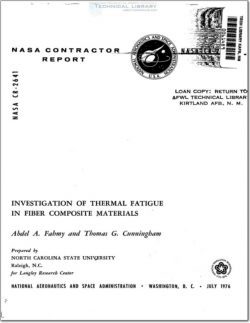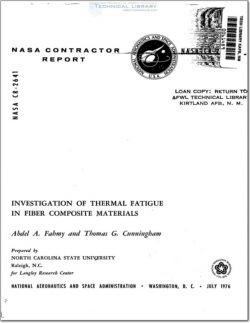NASA-CR-2641

- Version
- 191 Downloads
- 3.17 MB File Size
- 1 File Count
- August 16, 2016 Create Date
- August 16, 2016 Last Updated
Investigation of Thermal Fatigue in Fiber Composite Materials

INTRODUCTION
Only recently have graphite fibers been used to reinforce
plastics for ablative and structural composite applications. The
potential of graphite as a high strength, high modulus reinforcing
material became evident when graphite whiskers were produced with a
tensile strength of 20 x l09 N/m2
and Young's modulus values higher
than 70 x 1010 N/m2 (1).
Graphite fiber-reinforced composites have been widely used
since 1959 in ablative applications. It was not until six years
later, in l965, with the introduction of high modulus, high strength
graphite fiber that graphite—fiber composites were seriously considered
for structural application. Since that time, development and
evaluation of these composites have progressed at an increasingly
rapid rate (l).
This investigation was initiated to further evaluate the
graphite-epoxy composite material under conditions of thermal fatigue
and to make possible the production of better fiber composites
through a better understanding of the influence of fiber orientation
and lamination sequence on their thermal fatigue performance.
LITEkATURE SURVEY
Mechanical Properties
To evaluate the effect of thermal cycling on the elastic and
strength properties of a laminated composite, the elastic properties
and the thermal expansion properties of a unidirectional composite
of the same material and proportions must be known. In addition,
the configurations of the laminate and structural defects must be
known.
In order to study a laminated composite, it is necessary to
consider a unidirectional material composed of a parallel set of
cylindrical fibers embedded in a homogeneous matrix material. The
elastic constants of this material are evaluated as a function of the
average stress and strain imposed on the material. In the most
general case, this material may be orthotropic having nine independent
elastic constants. If a material such as continuous graphite fiber
is used, the individual layers have a multiplicity of filaments
through the thickness. A cross section, perpendicular to the fiber,
of the material would show a random distribution of fiber cross-sections.
This would indicate that the transverse plane would be a plane of
isotropy and that the composite would be treated as a transversely
isotropic composite with only five independent elastic constants.
For an existing material, the five independent constants can be
evaluated by direct experimental methods. Hill (2) developed
structural relations that simplified the problems associated with
determining these moduli. He was able to show the interrelation of
the axial Young's modulus, Poisson's ratio, and the plane strain
bulk modulus. By knowing these three, the other two effective composite
properties can be determined.
The experimental data generated for fiber composites are
usually directed toward their ultimate use in the form of shells or
laminated plate. In this case only four of the five independent
elastic constants are generally considered. These are the axial and
transverse Young's modulus, Poisson's ratio, and the axial shear
modulus,
Once the effective elastic constants of the unidirectional fiber
composite are known, the material may be viewed as a homogeneous
orthotropic material, Then for laminates formed from layers of
unidirectional composites, it is reasonable to treat each layer as an
orthotropic continuum, and to study the laminate using layered plate
theory. This theory is in widespread use for all types of composites,
and has been shown to be a suitable starting point for structural
analysis (3). The constants in this relationship are evaluated by
using the stress-strain relationship for individual plys or layers
and the Kirchoff Hypothesis for thin plates (4).
| File | Action |
|---|---|
| NASA-CR-2641 Investigation of Thermal Fatigue in Fiber Composite Materials.pdf | Download |

Comment On This Post